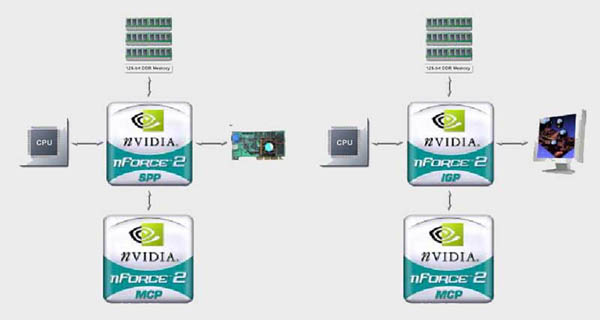 |
|
|
|
In the Forums... |
Posted: July 14, 2002 Written by: Davey McWatters NVIDIA nForce2 The Chipset IGP/SPP  DualDDR is based on the original nForce TwinBank technology. What NVIDIA has done with DualDDR is taken TwinBank and improved upon it to offer support for faster memory and more bandwidth. Instead of offering a single 128-bit memory bus, DualDDR offers two independent, intelligent 64-bit busses. They operate concurrently with each other and reduce latency by a great deal. The nForce2 chipset can support up to 3GB of RAM, 1GB in each of the three memory slots. The chipset offers support for up to DDR400 RAM. With the use of DualDDR, NIVIDIA is able to achieve 6.4GB/sec of memory bandwidth.  There are two north bridge options available for motherboard manufacturers to use. They include the IGP and the SPP. The major difference between the two units is integrated video. The IGP implements an integrated GeForce4 MX GPU, while the SPP has no form of integrated video. Don't let the picture of the SPP on page 1 fool you. I asked NVIDIA, and the SPP north bridge does not have integrated video. Perhaps they could be using the VGA ports for something else? With NVIDIA’s IGP north bridge, users have access to an integrated 256-bit GeForce4 MX GPU. This is far superior to any other form of integrated graphics available to date. If users decide not to use the integrated graphics, the north bridge also implements support for an AGP expansion slot. The AGP slot offers support for AGP 2.0 cards operating at 2x or 4x, and AGP 3.0 cards operating at 8x or 4x with fast writes. The integrated GPU offers NVIDIA’s Accuview antialiasing technology. The chipset also implements support for TV encoding, which will allow a user to attach their PC to their TV via s-video or composite and watch a DVD or play a video game on the big screen. One thing you must remember about outputting to a TV is that most normal TV’s don’t offer high resolutions. One of you overclocking demons' favorite features will more than likely be the ability to overclock the CPU, memory, and AGP busses all independently of each other. This will allow for even higher overclocks than are possible on current chipsets available on the market, which is good news for people who want the most out of their system. The chipset offers support for AMD Athlon/Duron CPU’s operating at a 133/100/66 FSB and allows the CPU and Memory busses to be clocked asynchronously of each other. Support for up to 3GB of DDR400 RAM is available at your disposal. |
||
|
| |||
|---|---|---|---|